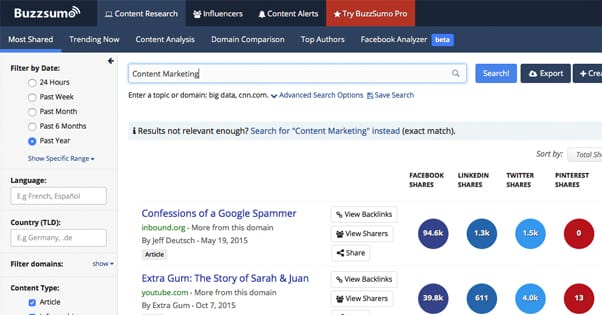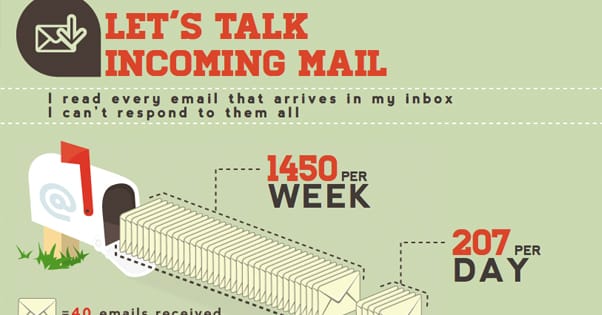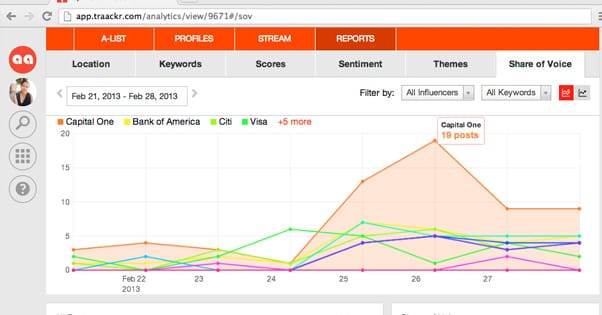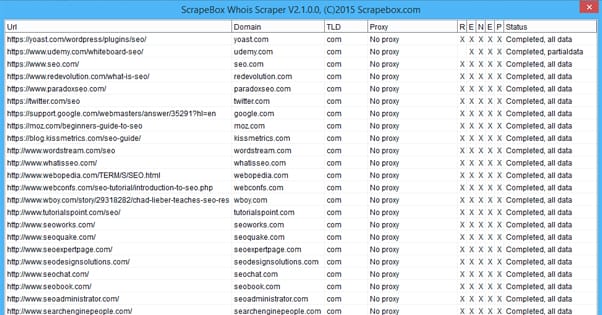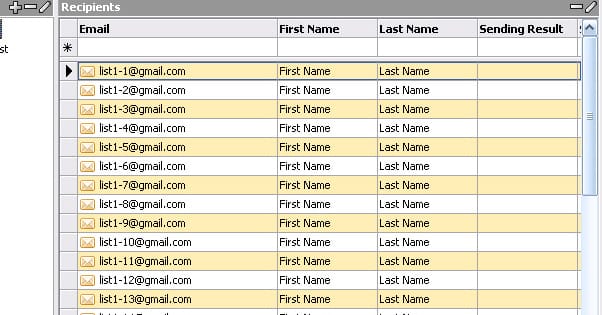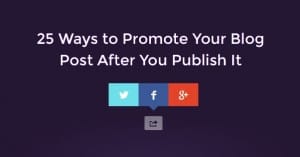How to Do Bulk Influencer Outreach on a Budget
Published by James Parsons • Content Marketing • Posted October 20, 2015 ContentPowered.com
ContentPowered.com
Who needs to be popular to get their posts seen by a huge audience? The answer is; not you. You can be a small business with an audience of 10,000 on Facebook, and you can reach millions of people if you play your cards right. That’s what influencer outreach is all about. This blog might not have a massive readership, but you can bet that a lot of people will see this post if someone like Neil Patel shares it.
Of course, the chances of Neil Patel sharing this particular blog post are pretty slim. He might share one or two from this blog, but unless we have a more mutually beneficial relationship going on, my content will need to be exceptional to get him to share. He’s a hugely popular influencer in the niche; of course he’s going to have limited brainspace – and limited social feed space – to use for this purpose.
That’s why what you need to do is bulk influencer outreach. You don’t just target the Neil Patels of your industry. You target anyone and everyone with a blog in your industry, anyone who might be interested in reading your content. Maybe you can’t get the attention of the one guy with an audience of 6,000,000 people, and that’s fine. If you can get the attention of 12 people, each with an audience of 500,000, you reach the same number of people. Plus, as an added benefit, you start off with 12 shares rather than 1. That will make the guy with 6,000,000 followers that much more likely to see and be interested in your content as well, so who knows; maybe you can hook him too.
Bulk influencer outreach is tricky to do right. The problem you face is determining which posts should be shown to which influencers. You can’t just make a list and treat it like a content digest mailing list. If you’re telling influencers every time a piece of your content goes live, you’re not performing influencer outreach. You’re spamming their inboxes with unwanted content that doesn’t have an unsubscribe link. That can actually get you in trouble according to the CAN-SPAM act, which regulates what sort of email messages you can send out.
Think of it his way. Frequently sending messages to influencers isn’t necessarily going to win their attention, and if it does, it’s just as likely to be negative attention. This is, despite the name “bulk outreach,” very much a matter of quality over quantity.
The process of influencer outreach in general is fairly simple.
- Identify a relevant influencer.
- Identify contact information and key topics for that influencer.
- When you publish a blog post, check to see if it meets the criteria for something that influencer might be interested in.
- If so, create a message to send to that influencer that notifies them of the publication of the content.
- Monitor the response you get from that influencer.
Different influencers will respond differently to different pieces of content. Many will ignore emails and messages entirely. Some will send polite but formulaic responses; “Thanks for bringing this to my attention, I’ll definitely check it out.” Some will respond more favorable in detail. Some will respond in a negative way, asking you not to message them again, though this is rare. Some will share your post without having responded to you directly.
Whatever their response, you want to note it down. Determine whether they’re receptive to your outreach, whether they’re resistant to it, or if they ignore it entirely. In every case, make sure you’ve noted down when you send them an interesting post, because you won’t be using that influencer again right away. That’s what I mean by avoiding spam, and that’s why you need to build a bulk list of influencers.
You can see why that process can be difficult and time consuming to do in any volume. You have to identify a lot of different people, harvest a lot of information about them, and determine which blog posts should be shared with which influencers. It’s a lot of initial investment, and a lot of data tracking on an ongoing basis.
What tools and options do we have, for free or for a minimal fee, that streamline this process? Let’s take a look.
Identifying Influencers
To a certain extent, you will know and be aware of influencers in your industry. If nothing else, you will know the sites where they reside. No one in web marketing or SEO can get away with not knowing about Quicksprout, Hubspot, Moz, KISSMetrics, Search Engine Journal, and a host of other sites. When you look a little closer, you will see many authors who write for several of these sites. These will be your highest tier of influencers, the big names that show up everywhere.
That’s the easy part. The hard part is identifying the sites and authors who aren’t quite at that level. They’re less prominent, they’re less popular, but they’re simultaneously less buried under unsolicited messages and less likely to ignore your messages completely. There might even be some influencers who you don’t realize are influencers, because they’re only influential on a social site you don’t use, like Google+ or LinkedIn.
So, what tools can we use to identify and codify these influencers?
- Traackr – This tool is specifically designed to help you discover influencers and build relationships with them. It also has tracking tools to help you pin down exactly how much a link or mention from a specific influencer is helping, in a tangible way. The problem with this tool is the price, which you won’t find on the site. Only the most premium tools make you contact them for a quote rather than publishing pricing information publicly. If you do have the budget, this is the tool to get. If not, read on.
- Little Bird – This second tool on the list is similar in many ways to Traackr, though it’s not quite as robust. They also don’t publish pricing information, but I’ve been able to find it online. For individuals with limited reporting needs, it costs $50 per month. Small businesses will typically go for the plan one tier higher, which is $250 per month but much less limited.
- FollowerWonk – This tool is created and maintained by Moz, which means it has to be quality. It’s also limited compared to the two above tools. It specifically analyzes Twitter data alone. It will find you Twitter influencers, but it won’t help you with influencers who don’t use Twitter. On the plus side, it’s free.
- BuzzSumo – This has many of the same perks, methods, and means of data collection as FollowerWonk, and it works in the same sort of way. You plug in keywords and it spits out the high profile content, influencers, trends, and domains in that niche. Some of the data is free, but to get the real meat on influencers you need to get the $99/month plan.
- Kred – This is one of those “free” tools that is actually only free for a year, after which you may have to pay an additional fee. It’s also trying to combine influencer datamining with social media by creating its own tribe, but I have no idea if any legitimate influencers use it. On the plus side, you can try it free for a year just for tweeting about them.
Using these tools – particularly BuzzSumo – can get you a really good idea of what influencers exist in your niche.
Here’s a trick. All of these plans with monthly fees? You don’t really need more than one or two months, depending on how much you work in a short time frame. If you’re truly operating on a tight budget, you’re going to be keeping track of data on your own, likely in a spreadsheet. That’s fine! As always, it’s a choice you have to make, between spending money and spending time. I recommend buying one of these products for a month or two, then cancelling them when you’ve harvested the relevant data. If you’re quick about it, it shouldn’t take more than a week, and you can keep the tool around for the first month for testing purposes. Who knows; maybe you’ll like it enough to keep paying for it.
One other source of information you can use is looking at the other blogs followed by the people who follow you. Send out a poll in your newsletter or on social media and ask for suggestions; your fans will be happy to tell you about their favorite blogs and authors.
Harvesting Contact Information
Unfortunately, other than the above tools, there’s no real good way to pull in contact information for your influencers. You’ll just need to take your list of names and fill in the relevant details by hand. Email address, website contact form or tip line, social media profiles you can message them on, they’re all good to record.
Another crucial point of information to write down is an estimation of the sorts of traffic these influencers get regularly. What sort of traffic do their blogs get? What social shares, comments and engagement metrics do they get? What is the MozRank of their site? This is all information that helps you rank the quality and reach of the influencers you’re tracking.
An influencer with a small reach is still a good influencer, particularly if their audience is potentially quite interested in your brand but unaware that you exist. These can actually be more valuable than some of the bigger names, because the traffic is potentially more targeted. It won’t have the same volume, but it will be more likely to convert into actual readers of your blog.
It is at this point that you will have some decisions to make. One such decision is what you might offer as an incentive or as compensation for influencer shares. Some influencers are perfectly willing to accept money in exchange for sponsored posts, though many are iffy on the prospect. This is something you should sound out and note down, assuming you’re willing to pay. You can also offer social shares and links in exchange, if you have the audience to make it potentially valuable to them. You can also often nothing, and just rely on the quality of your content standing on its own. Products, giveaway sponsorship, shout outs; there are all sorts of forms of compensation if you’re creative.
You will also need to determine how often to message each influencer. I recommend not often. You want to save your true bulk simultaneous outreach for the content you’re really trying to push, like a new product launch, a high profile infographic, or an e-book release. You don’t want to spam any of your influencers, so you’re going to want to be careful about how often you reach out to each of them.
Of course, reaching out to an influencer might be the gateway to a more lucrative partnership, and I’m not going to stop you there. It’s always better to have a partnership than it is to have a one-sided influencer relationship. Just avoid the most black hat schemes like thin guest posting and weird link schemes.
Contacting Influencers
I’m not going to give you a form letter or a mass email tool to use to send messages to your influencers. That way lies spam, and spam leads to madness. Instead, I’m going to give you resources and tips to help you create a message.
Creating an outreach message is going to be a very personalized experience, because it needs to reflect what your relationship is with the influencer, how close or far they are to your traffic levels, how the content fits with their blog, how much you’re pushing the content, your past outreach success or failure, and your brand voice. That’s why I can’t give you a form letter; it just won’t work for most of you.
There are ways to reach an influencer other than email. Using the same social media platform they prefer, start to engage with and communicate with them. Reply to tweets, start conversations, comment on blog posts, and generally make yourself a valuable part of their community. Your goal is for them to recognize your name when you do send them a message.
Now, this can take a lot of time, so you need to scale it towards the importance of the influencer in question. Put more effort and time into the “holy grail” influencers, and scale back for the influencers on par with your business. Even if this seems to run counter to my concept that small influencers can have larger payoffs, it makes sense. You don’t need to compete with as many people to stand out and be noticed on a smaller influencer’s page.
I recommend using some kind of specialized setup for your email campaigns, if nothing else. Whether it’s an email automation tool or just a robust suite of tools like MailChimp or Aweber, anything is better than a stock Outlook inbox.
Additional Outreach Tips
These are tips that will help you along your way, but which aren’t applicable to other parts of the process, or are more important to know in general.
- Remember that just because someone is an influencer to you doesn’t mean you’re not an influencer to them. An influencer relationship can be two-way.
- Remember that time is valuable – something you need to be keenly aware of for budget bulk outreach. Keep your outreach messages short and to the point.
- Make sure you provide the influencer with everything they might need to share your post; links, videos, images, reference links, even a Dropbox link if necessary.
- When an influencer promotes your content, make sure you do your part! Retweet, share, and repost their mention to give it additional traction.
- Offer more than you need to. If you’re trying to get a mention about your product, offer a free copy of that product, some copies to give away, an affiliate program if you have one, and of course quality content on your site. Even if the influencer doesn’t want to run a giveaway and doesn’t care about your affiliate program, they’re there in case they want them.
Perhaps one of the biggest tips I can give you, though, is to make sure influencer outreach is right for you before you invest heavily in it. Some businesses, some brands, just aren’t built for an online audience. People might not want to read about your business selling valves; it’s just not that interesting, no offense to the valve enthusiasts out there. Many B2B businesses have trouble with influencer outreach because the influencers they contact don’t have audiences comprised of other businesses. They’re effectively just networking one on one, the shares or blog links aren’t valuable. Some brands just don’t have a niche where outreach is valuable.
In the end, outreach is something you’ll have to muddle through a little bit. Ideally, I’ve been able to streaming the hardest and most tedious part; identifying and codifying your influencers. From there, the rest is all personal relationship building and finding out what people like.
